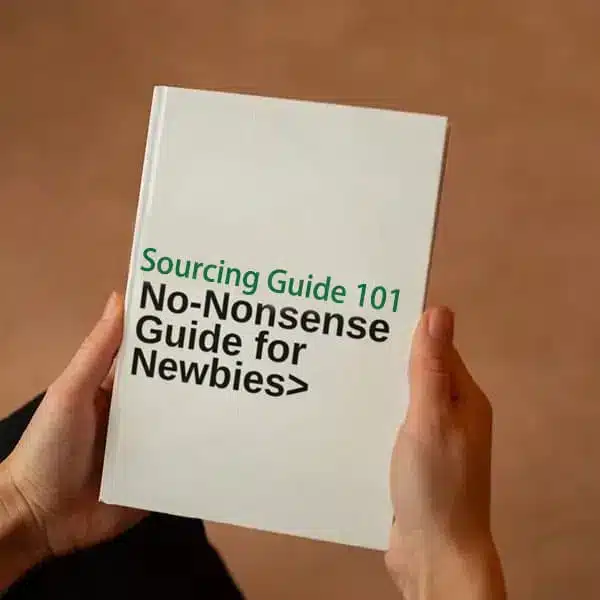Trying to pick between China’s tech city and Vietnam’s new hot spot for your electronics? A wrong move can lead to delays, high prices, and a batch of bad products.
For tricky, new electronics that need lots of different parts fast, Shenzhen is your best bet. For making large amounts of a simple, existing product where you want the lowest worker wages, Vietnam is a good option. It really depends on how complicated your product is.
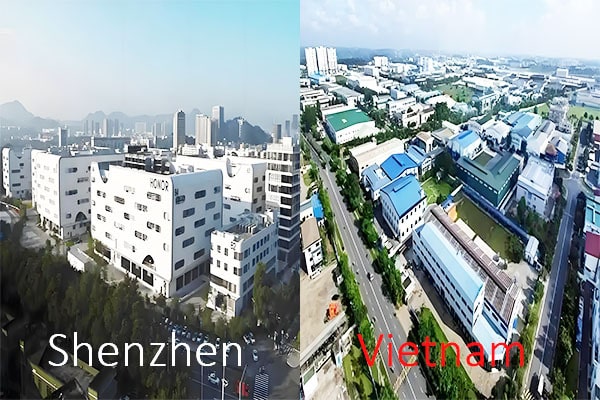
But what does this actually mean for the money you spend? Let’s look at them side-by-side, comparing the five big things—cost, parts, quality, product type, and making samples—so you can pick the best place for your electronics business.
What’s the difference in worker costs in China & Vietnam?
You might worry that paying workers in China will eat up all your profits, Vietnam seems cheaper when you look at the numbers, but does the hourly wage tell the whole story?
You can pay factory workers in Vietnam up to 50% less than in China. The average monthly pay is around $250–$400, while in Shenzhen it’s more like $500–$800. But for tricky electronics, China’s skilled and efficient workers can often mean a lower final cost.
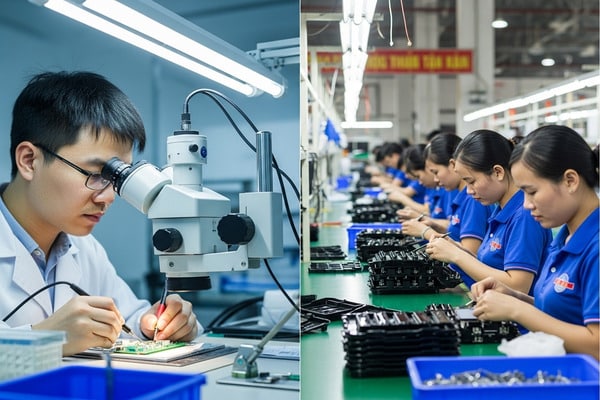
Just choosing a place based on wages can be a big mistake. Vietnam can save you a lot on labor—some 2025 data shows savings of about 50% compared to China—but you have to think about what you’re getting for that money. For example, the average electronics worker in Vietnam makes a certain amount, but there’s more to it.
More Than a Price Tag: Wages vs. Skill
Workers in Shenzhen get paid more because they have years of experience making complicated electronics. This means they work faster, make fewer mistakes, and don’t need a lot of training, which saves you money in the end. It’s true that factory workers in China can earn 2-4 times more than in Vietnam, but that’s because of their skill level. If your product is simple to make, Vietnam’s lower cost is great. If it’s tricky, the skilled workers in Shenzhen are often worth the extra pay.
How a Partner Helps You Find the Real Cost
To figure this out, you need someone on the ground who knows what to look for. A sourcing partner can check how well a factory works and how many mistakes they make, not just the prices they give you. This helps you choose based on the final price to get the product to your door, not just one number on a sheet.
| What to Look At | Shenzhen, China | Vietnam | What This Means for You |
|---|---|---|---|
| Worker Pay (Avg. Monthly) | ~$500 – $800 | ~$250 – $400 | Vietnam is cheaper for simple jobs. |
| Worker Skill Level | Very High | Getting Better | Shenzhen is better for products that are hard to make. |
| How Fast They Work | High | Medium | Faster work in China can make up for higher pay. |
Which country is better for getting parts for electronics?
You found the perfect factory. But what if they can’t get an important part? If the system for getting parts is weak, your whole project can get stuck.
Shenzhen has an amazing system for parts, making nearly 90% of all electronics in the world. You can find any part you need in just a few hours. Vietnam’s system is growing, but it still has to buy many raw materials and parts from other countries, which can cause delays and add costs.
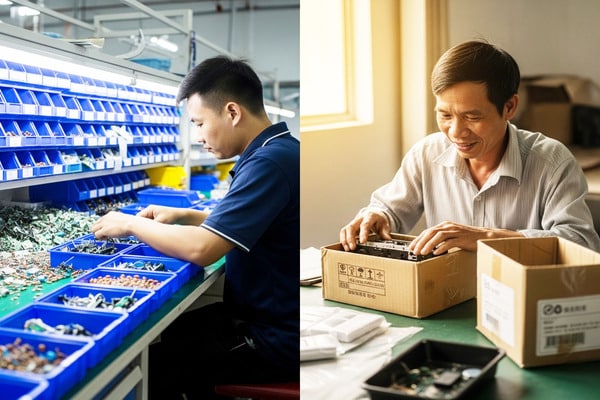
A good system for getting parts is the key to making things smoothly. It decides how fast you can make your products and how much it will cost. China has a huge advantage because it makes 50-60% of basic materials like steel and aluminum. Meanwhile, Vietnam’s system for making electronics is still new and doesn’t have the same variety of local parts.
Shenzhen: The World’s Supermarket for Electronics
Imagine you need a special computer chip. In Shenzhen, you can get it the same day. As one expert said, "The huge network of suppliers in China just isn’t there in Vietnam. Shenzhen is a one-stop shop for everything electronic." This means things get made faster, parts cost less, and you can make changes easily. It’s why our sourcing services are based here—to give our clients access to this incredible setup.
The Hidden Risk in Vietnam
Since factories in Vietnam buy a lot of their electronic parts from China—they bought $33 billion worth in 2024—your project could get delayed if there are shipping problems between the countries. This is a big risk if you need to get your product to customers quickly. A good sourcing agent can manage this for you so you don’t have to worry about surprise delays.
How is quality control different in Shenzhen and Vietnam?
The last thing you want is to open a box from your supplier and find it’s full of bad products. It’s a huge fear for anyone selling online. So, how do you make sure your products are good when they’re made so far away?
Both countries can make great products. The big difference is how they do it. Factories in Shenzhen often use smart machines to make things perfectly right every time. In Vietnam, more work is done by people, so you need someone there checking things carefully to get good results.
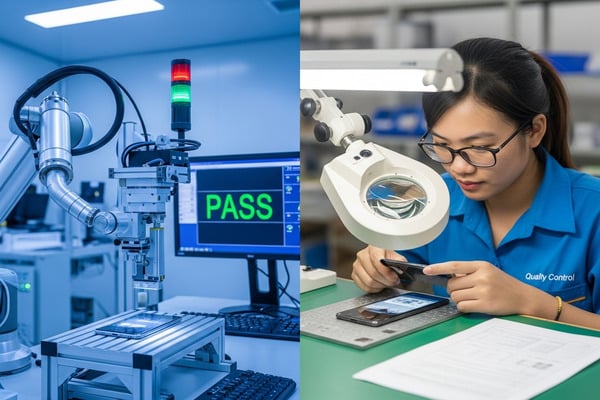
Good quality isn’t about the country, it’s about the process. Some say you can get the same quality in Vietnam as in China, and a Samsung phone made in Vietnam is just as good as one from China. But making sure the quality stays high every time takes work.
Machines vs. People: Which is Better for You?
If your product needs tiny, super-exact parts, like a complex circuit board, the machines in Shenzhen are better. They reduce human mistakes. If your product needs to be put together by hand, then the workers in Vietnam can be great, as long as someone is checking their work.
Why You Need Someone to Check Quality
No matter where you make your products, you need your own "eyes and ears" in the factory. Even if 70% of factories in Vietnam have an ISO quality certificate, the rules aren’t always followed.
What kind of electronics are best to make in Vietnam vs. China?
Your product isn’t just a generic "thing." Is it a simple gadget or a brand-new, complex device? If you make it in the wrong place, it could fail before you even get started.
You should choose Shenzhen for new products that need lots of testing, circuit boards (PCBs), and new devices that need a lot of different parts. But if the products are very mature on production, and quantity is big, you should choose Vietnam to save money on putting together large numbers of existing products, like TVs, printers, or appliances.
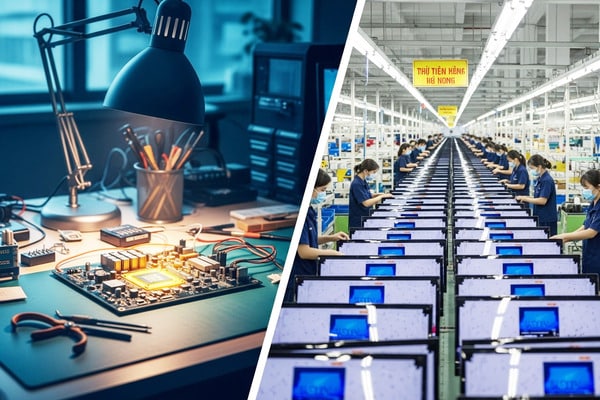
| Best to Make in Shenzhen, China | Best to Make in Vietnam |
|---|---|
| ✅ First Samples of New Products | ✅ Everyday Electronics (TVs, appliances) |
| ✅ Drones & Smart Devices | ✅ Assembly Smartphones |
| ✅ Circuit Boards (PCBs) | ✅ Printers & Copiers Assembly |
| ✅ Products with Custom Parts | ✅ Simple Products Made in Large Numbers |
Matching your product to the right place is the secret to getting things made without headaches. Vietnam is now a major player for certain things. Electronics are Vietnam’s top export, and big names like Samsung, LG, and Intel have huge factories there. For instance, Samsung makes most of its Galaxy phones in Vietnam.
Shenzhen is Best For: New and Complicated Stuff
If your product is new, needs special parts, or has a complex electronic brain, Shenzhen is really the only place to go. Most of the products made in China for foreign companies are things like mobile phones and circuit boards. The city is built to help create new things from scratch. We share a lot of tips for this on our blog.
Vietnam is Best For: Big Batches and Assembly
Think of Vietnam as a great place for the final step: putting things together. Big companies send their finished designs and parts there to be assembled for a lower cost. If you have a product that already sells well and you just need to make a lot of them, Vietnam is a fantastic choice.
Which place is better for making a prototype?
Have a great idea for a new product, but don’t know how to make the first one? How fast you can go from an idea to a real, working sample can decide if you’re a market leader or get left behind.
Shenzhen is, by far, the best place in the world for making electronics prototypes. You can get any part you need, find services to make custom pieces quickly, and work with lots of smart engineers. You can build and test a sample in days, not months.
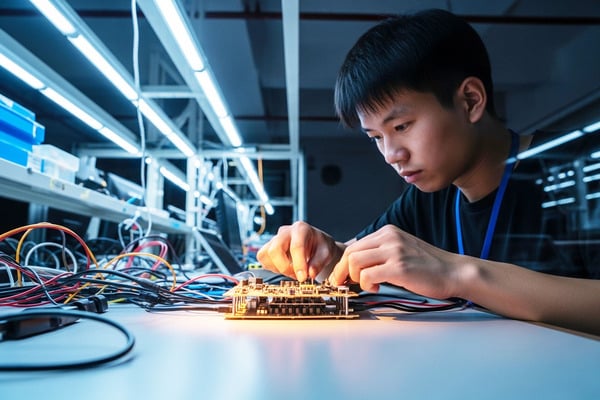
For any new business launching an electronic product, speed is everything. Shenzhen has grown from just a place to make things into a world-leading city for creating new hardware prototypes. In Vietnam, the focus is on "fairly simple assembly. There’s not a lot of design activity." Even though big companies like Intel have a $1.5 billion testing facility in Vietnam, the actual inventing and creating happens in Shenzhen.
The "Shenzhen Speed"
This isn’t just a cool name. It’s real. You can have an idea in the morning, go to the famous Huaqiangbei electronics market to buy parts in the afternoon, and have a working sample the next day. This ability to make changes quickly just isn’t possible anywhere else.
Your Idea, Made Real
This is where a sourcing partner can really help. We can connect you with the right engineers and workshops in Shenzhen to turn your idea into a real product. We’ll guide you through all the steps until it’s perfect and ready to sell.
Conclusion
Choosing between Shenzhen and Vietnam really comes down to how new or complicated your product is, Shenzhen is your first stop for electronic product development. But you don’t have to figure this out on your own. At Green Sourcing, we can be your team in China. We help you find the right factory, check the quality, and handle the whole process so you can focus on selling and growing your business.
Ready to get your product made in China without the stress? Contact us for a free chat today. Let’s build your next great product together.
FAQ
-
Is it always cheaper to make things in Vietnam than in China?
- Not always. The workers cost less in Vietnam, but for complex electronics, the skilled workers and easy access to parts in Shenzhen can make the final cost to your door lower.
-
I’m a small business. Can I order small amounts from China?
- Yes! Many people think you have to place huge orders in China, but that’s a myth. A good sourcing agent like us can connect you with factories that are happy to work with small businesses and accept low-quantity orders.
-
How do I protect my product idea in these countries?
- Protecting your idea is super important. The best way is to register your brand name, use special contracts (called NNN agreements) to stop people from copying you, and work with a trusted partner who checks out factories for you.
-
What’s the biggest risk if I choose Vietnam?
- The biggest risk is that Vietnam needs to get many of its electronic parts from China. If shipping between the two countries gets delayed, your production can stop. This risk is much lower when you make your product right in Shenzhen, where all the parts are.


